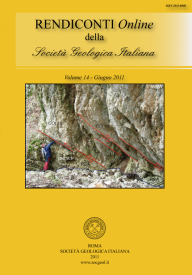
Note illustrative della carta geologica dell'area urbana di Bari in scala 1:25.000
Piero Pieri (*), Luisa Sabato (*), Luigi Spalluto (*) & Marcello Tropeano (*)
Progetto CARG, rilevamento geologico, geologia delle aree urbane, area metropolitana di Bari, Murge, Puglia
Volume: 14/2011
Pages: 26-36
Abstract
Notes to the geological map of the urban area of Bari (southern Italy) 1:25.000 scale.
This paper shows the results coming from the detailed geological mapping performed on the urban area of the city of Bari (Puglia region, southern Italy). It is a large area (about 50 km2), with many inhabited places, and intensely urbanized. For this reason a geological map that could provide an up-to-date and useful tool for professional geologists daily working on the region, was realized.
The area represented in the geologic map of the urban area of the city of Bari, at the scale 1:25.000, lies on the eastern Murge, which represents the central part of the Apulian foreland, the south-Apennines foreland. In the Murge area, the foreland is characterized by a thick Mesozoic sedimentary succession overlain by relatively thin and discontinuous Quaternary deposits. Locally, the exposed Mesozoic succession is about 150 m thick, and is represented by a part of the Calcare di Bari Fm, made up of biopeloidal and peloidal wackestones/packstones alternated with stromatolitic bindstones with frequent intercalations of dolomitic limestones and grey dolostones. Depositional environments are related to a low-energy inner-platform depositional system and biostratigraphic data allowed us to refer the age of the succession cropping out in the city of Bari to the Late Albian-Early Cenomanian.
The lower Pleistocene Calcarenite di Gravina Fm unconformably lies on the Calcare di Bari Fm. The lower boundary is transgressive and is locally marked by reddish residual deposits (terra rossa) and/or by brackish silty deposits passing upward to shallow-water calcarenites rich in bioclasts. Basically this formation is made up of litho-bioclastic calcarenites and calcirudites with packstone/grainstone texture, rich in mollusks, red algae, serpulids, echinoids and benthic foraminifers. The thickness of this unit ranges from few metres up to 20 m, and its depositional environments are related to alluvial or offshore systems. The age is early Pleistocene (Gelasian?-Calabrian). Regionally, the Calcarenite di Gravina Fm represents the record of the lower Pleistocene subsidence of the Apulia foreland.
The Murge supersynthem groups all the marine terraced deposits unconformably lying on all older units and consists of a heterogeneous assemblage of mixed silicoclastic and carbonate sediments formed in shallow-marine and transitional environments. The thickness of the three synthems forming the supersynthem is usually few metres thick and the age ranges from middle to late Pleistocene. These synthems record a phase of regional uplift which started at least from middle Pleistocene; this uplift, in combination with the Pleistocene glacioeustatic oscillations, produced several relative sea-level changes which caused the distribution of these synthems to different altitudes above sea level.
The lame delle Murge supersynthem groups all the terraced alluvial deposits cropping out in the studied area. These deposits unconformably lie on the previous units and are placed at different heights inside little canyons, characterizing the area and locally named "lame". These deposits consist of either well cemented or poorly cemented carbonate conglomerates with a reddish silty-sandy matrix. The thickness of these deposits ranges from few metres up to 10 m and the age is middle Pleistocene-late Pleistocene.
The picture is completed by upper Pleistocene-Holocene actual and present-day alluvial deposits, made up of carbonate gravels with reddish fine-grained matrix.
Keywords
Progetto CARG, rilevamento geologico, geologia delle aree urbane, area metropolitana di Bari, Murge, Puglia
Get Full Text